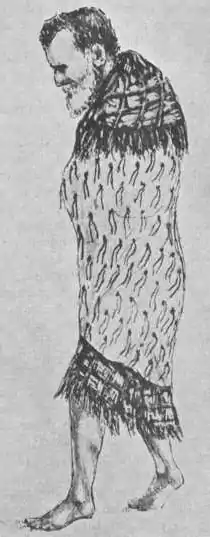Te Whiti o Rongomai
Te Whiti o Rongomai III (c. 1830–18 November 1907) was a Māori spiritual leader and founder of the village of Parihaka, in New Zealand's Taranaki region.

Te Whiti established Parihaka community as a place of sanctuary and peace for Māori many of whom seeking refuge as their land was confiscated in the early 1860s. Parihaka became a place of peaceful resistance to the encroaching confiscations. On 5 November 1881, the village was invaded by 1500 Armed Constabulary with its leaders arrested and put on trial. Te Whiti was sent to Christchurch at the crowns insistence after it was clear the crown was losing its case in New Plymouth. The trial, however, was never reconvened and Te Whiti, along with Tohu were held for two years. Te Whiti and Tohu returned to Parihaka in 1883, seeking to rebuild Parihaka as a place of learning and cultural development though land protests continued. Te whiti was imprisoned on two further occasions after 1885 before his death in 1907.
Biography
Te Whiti was born in Ngamotu, Taranaki, New Zealand in 1830, the son of Hone Kakahi of the Te Ati Awa tribe and Rangi Kauwau. Educated at a mission school, he later set up a flour mill in Warea.
In 1860 Te Whiti was responsible for saving the lives of the crew and passengers of the Lord Worsely which was wrecked on the Taranaki coast 80km south of New Plymouth. When Māori threatened the survivors on the beach he came to the rescue. He had a bullock killed and fed the survivors, sending a message to New Plymouth and arranged transport in carts to escort the survivors back to New Plymouth. This was the first time the government officials knew of the existence of Te Whiti. He was believed to be about 30 at the time. In 1867, the great Māori chief established a village at Parihaka. He wanted his people to regain their land, pride and self-respect after the confiscations in other parts of the North Island. His aim seems to have been to establish a new way for Māori to resist European attempts to take what was left of Taranaki.
With his close relative, Tohu Kakahi, Te Whiti led the people of Parihaka in their nonviolent resistance to the confiscation of Māori land by the New Zealand Government. He was the son of Tohukakahi, a minor chief of the Patukai hapu of the Ngati Tawhirikura branch, Te Ati Awa tribe, and of Rangiawau, daughter of Te Whetu. As a youngster, Te Whiti was well educated by Māori elders, who taught him about the traditions of his culture.
It also appears preacher Minarapa Te Rangihatuake taught Te Whiti scripture and to read and write. Te Whiti also became a pupil of Lutheran missionary Johannes Riemenschneider. While the Parihaka prophet turned his back on all acts of violence, he wasn't going to give up land without a fight. And so, passive resistance was born.
"Though some, in darkness of heart, seeing their land ravished, might wish to take arms and kill the aggressors, I say it must not be. Let not the Pakehas (sic) think to succeed by reason of their guns ... I want not war, but they do. The flashes of their guns have singed our eyelashes, and yet they say they do not want war ... The government come not hither to reason, but go to out-of-the-way places. They work secretly, but I speak in public so that all may hear," Te Whiti told his people in March 1880.
By that time, Parihaka was a stronghold of Taranaki Māori opposition to the loss of tribal lands, which arose from the Land Wars and subsequent Crown legislation. The government passed the Suppression of Rebellion Act 1863 to punish Māori rebels who had fought against the government mainly in Taranaki and the Waikato. This defined Māori fighting against the government as rebels, who could be detained indefinitely, without trial. While Te Whiti and Tohu Kakahi were incarcerated, Māori ploughmen came from all over the country to assist them to re occupy their confiscated land and prevent the building of roads. Hundreds were arrested and their property confiscated. Reports of the Māori Ploughman's nonviolent struggle in the British media influenced the thinking of Mohandas K. Gandhi in South Africa.[1]
References in modern culture
- Popular Dunedin artist Jeremy Callander wrote a song about Te Whiti and Parihaka.
- Tim Finn has a song on his self-titled album called "Parihaka" about Te Whiti.
- Don McGlashan has a song titled "18th Day" which is about the return of Te Whiti from detention[2]
- On the album Pendulum by Little Bushman, there is a song titled "Peaceful Man" which is about Te Whiti.
- Numerous artists have used Te Whiti as a subject or inspiration, among them Colin McCahon (with his painting Te Whiti, Tohu) and Ralph Hotere (Te Whiti drawing-painting), both of which were produced for a 1972 exhibition about Te Whiti, "Taranaki Saw it All".[3][4]
References
- Scott, Dick (2004). Ask That Mountain: The Story of Parihaka. New Zealand: Raupo Publishing.
- album review in The NZ Listener
- Auckland Art Gallery: Te Whiti, Tohu
- Christchurch Art Gallery: Te Whiti Drawing-painting Archived 22 February 2013 at the Wayback Machine
Sources
- The Fox Boy. P Walker. Bloomsbury. 2001. (ISBN 0 7475 5347 5)